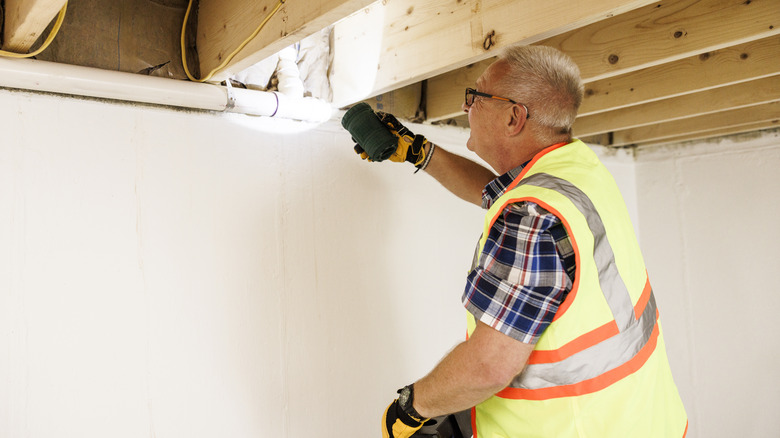This Kitchen Ingredient Is The Key To Killing And Cleaning Household Mold
If the conditions are just right, mold can develop around your home over time. While kitchens and bathrooms are common areas susceptible to mold since they frequently have moisture in the air, places with poor ventilation like basements and laundry rooms are also at risk. Where moisture is prevalent, mold develops on surfaces like tile, grout, shower curtains, or underneath seals and gaskets that provide a water source. Similarly, mold thrives in locations that have food particles or spills since they provide access to nutrients. Finally, if you have areas of your home that are not well-ventilated, moisture can build up and foster mold growth. Nevertheless, you likely already have a mold-fighting kitchen staple in your pantry: baking soda.
Baking soda is effective at fighting mold due to its alkaline and absorbent nature. Mold typically thrives in more acidic environments, so the chemical compound's natural alkaline properties can disrupt this space and prevent the fungus from growing. Moreover, baking soda's ability to soak up moisture saps away the damp conditions that mold requires to grow. Finally, since baking soda is mildly abrasive, it's great at cleaning mold from porous surfaces, simultaneously neutralizing any odors the spores may have left behind. Thus, baking soda is a non-toxic and eco-friendly solution to your mold miseries.
How to kill mold with baking soda
Using baking soda to kill and clean mold in your home is a simple and convenient process. To get started, make a paste by combining baking soda with water. Use an equal ratio of both ingredients and mix them together in a small bowl. For extra mold-fighting power, add a splash of vinegar — but expect the paste to foam and bubble first as baking soda and vinegar cause a fizzing reaction.
Once you've made the paste, apply it directly to the moldy spots in your home using a brush, sponge, or cloth. It's a good idea to wear gloves and a mask as mold spores can be detrimental to your health, especially if you have sensitive skin or respiratory issues. If you want, wet the moldy area first with water using a spray bottle or sponge to help the paste stick to the surface. Once you've applied the paste, allow it to sit for at least 10 minutes. For areas that are particularly infested, it's best to let the paste sit longer — a few hours should do — and allow it to penetrate and kill the mold, neutralizing the acidic environment. After, use a damp cloth or sponge to scrub away the paste and residue, then rinse and dry the surface. For stubborn stains, you can repeat the process with an abrasive scrubbing tool.
Cautions for using this method
While baking soda is generally safe and effective for banishing mold from the home, there are some cautions to consider before trying this method. Though baking soda is non-toxic and safe for many surfaces, it does tend to bleach certain materials, especially if left on them for an extended period of time. Test the baking soda paste on a small, inconspicuous area before applying it to larger surfaces prone to bleaching.
Using baking soda to kill and clean mold from your home is a great tool that can tackle mild infestations, but to truly combat the fungal growth, it's better to identify the root of the issue. Increasing ventilation, using a dehumidifier to reduce moisture, and cleaning up food and spills will help prevent mold from flourishing. If you've tried all of these options, it may be best to consult a professional company for recommendations on how to prevent mold from continuing to grow in your home.
Finally, baking soda is a great tool for smaller, manageable cases of mold, but it's better to call in professionals if you have a severe case of mold or suspect that the particular species may be hazardous. Mold can be incredibly detrimental to your health if improperly handled, so it's a good idea to default to a company if you're uncertain about the type of fungus growing in your home.


